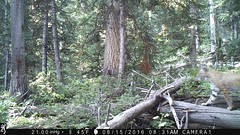Hudson’s Mud Bugger and Sand Bugger Variations
There seems to be quite a few variations of the Hudson’s Mud Bugger fly that have appeared, and there’s probably no end to the fun stuff you could do with it.
Here are a few variations:
Tier: Gregg Martin.
Notes: I use predominately a scud type hook size 6, but some also the M3366 or equiv. I try to match the tail to the hackle, either sili-legs or spanflex, sometimes centipede or tarantula legs. I like staight up tan for carp, but only recently came upon good hackle so only have a few tied up.
If any other tiers have other variations, send a pic or a link, and I’ll post them here.
Best Outdoor Sports Related “Sh*t People Say” Videos
I’m sure you’ve seen a number of “Shit People Say” videos lately. Yeah, I know, that’s sooo last week, and you’re probably tired of them by now. That said, here are a few outdoor sports iterations of the popular internet meme.
Sh*t Cyclists Say
Sh*t Runners Say
Sh*t Ultrarunners Say
Sh*t Fly Fishermen Say
Sh*t Triathletes Say
Sh*t Kayakers Say
Sh*t Skiers Say
If you come across any other interesting ones, let me know.
The Color of a Crayfish
When I’m tying flies, I’m always conscious of material colors. Sometimes it doesn’t really make a difference, but sometimes it does. Present a strange color (or size) to a pressured fish and they’ll likely bolt in the opposite direction. When I fish crayfish patterns, I typically have the best results with shades of green. But why?
If you were to ask the average person to draw and color a crayfish, you’d probably end up with something that looked like a bright red dwarf cooked lobster. In fact, the only red crayfish I’ve ever seen was a cooked one at a Cajun crayfish boil. So why are there so many crawfish dubbing colors offered in the shade of red and/or orange? Most of the mud bugs I see in the wild are various shades of brown, rust, green, and even blue.
A 1901 article in The American Naturalist sheds some light on the color of the crayfish…
“It was first noticed, while studying the habits of crayfish by observations in field work, that the color of itzulmunis in nearly all cases closely resembled the color of the environment. In one small pond of water, where the soil at the bottom was a blue clay, the crayfish were all blue in color. In another pond with a black, muddy bottom they were all black, and in still other places of different colors. But in nearly all cases they were of the same color as the environment”

Crayfish can adapt their color to their surroundings. Here a crayfish blends in with the blue gravel of an aquarium.
The article also explains the occasional red or rust color observed in a few crayfish…
“One exception to this was found with those which were red. These were confined entirely to the shallow water in the small streams, and the color was not always similar to the color of the environment. The crayfish in all colors except red were found almost entirely in the ponds with deeper water and muddy bottoms. But it was discovered later that this red color in crayfish may be caused by exposure to sunlight.”
So, in addition to environment, it appears color variations in crayfish can be attributed to age, size, molting stage, and migratory pattern. Next time you see a crayfish note its color and the color of the surroundings. It might help you become a better fisherman.
Source: W. J. Kent, The Colors of the Crayfish, The American Naturalist, Vol. 35, No. 419 (Nov., 1901) (pp. 933-936)
Tags
art Bahamas bass beer bonefish books brook trout brown trout bucket list carp colorado river cutthroat trout cooking drawing drink eggs environment family fly fishing fly pattern fly tying George Leonard Herter german shorthair pointer Grand Canyon Grand Canyon National Park greenback cutthroat trout homebrew horses humor hunting Indian Peaks inspiration iphone kayaking kids landscape moose mountain whitefish mud bugger Norman Maclean painting photography pike quotes quoute rainbow trout reading redfish Rocky Mountain National Park running shag nasty skiing south platte speckled trout trail running training travel trout video winterArchives
- October 2013 (1)
- May 2013 (1)
- February 2013 (5)
- January 2013 (5)
- December 2012 (1)
- October 2012 (1)
- June 2012 (1)
- March 2012 (4)
- February 2012 (1)
- January 2012 (4)
- November 2011 (6)
- October 2011 (6)
- September 2011 (6)
- August 2011 (9)








